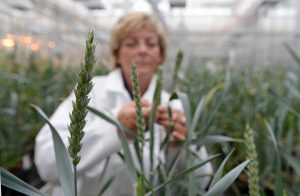AWS for Industries
Executive Conversations: Building Resiliency with Bob Reiter, Head of R&D, Bayer Crop Science
Bob Reiter, Head of R&D of Bayer Crop Science, joins Elizabeth Fastiggi, Worldwide Lead of Agriculture Business at AWS for a discussion on recent disruptions in the global food supply chain, examples of farmers building resiliency through data and analytics, and future trends for sustainability. Crop Science, a division of Bayer, provides a range of products and services to enable sustainable agriculture for farmers worldwide.
This Executive Conversation is one of a series of discussions held with industry leaders, where we seek to learn more about their resiliency, tenacity, and capacity for innovation.
—
Elizabeth Fastiggi: What do you see as the major impact COVID-19 has had on farmers?
Bob Reiter: We saw four overarching effects COVID-19 had on farmers. First, there was an immediate disruption in some parts of the supply chain that were most at risk. Agriculture has a highly integrated supply network that allows consumers access to foods from many different parts of the world. While that global supply chain was disrupted, we also saw several examples of resiliency through market ingenuity. For example, a mix of local businesses and producers joined forces to sell food through venues like pop-up stores to help offset gaps in supply. Second, changes in consumers’ behavior affecting the price of certain commodities, including corn. Because so few people are commuting to work, consumption of gasoline decreased. And because we blend corn-based ethanol into our gasoline, that reduction in consumption has negatively affected demand, resulting in lower commodity prices for farmers. Third, the established patterns in our food consumption changed. We’re eating out less and at home more, so the mix of products on the demand side changed, disrupting the processing and distribution channels that farmers supply. And finally, we’ve seen many farmers grapple with labor challenges. In certain places, just finding sufficient labor to maintain or harvest crops became extremely difficult. For Bayer in particular, we rely on labor in the summertime to assist in the growing season. We had a hard time finding those workers and, when we did, it was a real challenge to keep them safe, given the COVID-19 restrictions.
EF: How are farmers leveraging technology to manage these shifting circumstances?
BR: For farmers, the biggest decision they make each year is determining which crop to plant and how much to grow. Depending on those answers, they face a vastly different set of market opportunities. Technology also comes into play, so that farmers can better match those supply and demand signals, using things like long-term weather forecasting and market assessments to determine what to grow. Predicting how much corn to plant, for instance, comes down to evaluating the relevant data. I’ve always been impressed by the example of forecasting tomato demand by looking at the number of internet searches for pasta recipes or fresh salads. But many farmers are still trying to figure out how to use data and analytics more effectively. We saw some late-stage shifts in corn and soybean production due to the pandemic, and being able to have critical data insights can give farmers the ability to react and respond to those demand surges faster.
EF: Resiliency is about responding and adapting. How do you think farmers are using data and insights to achieve resiliency, and more broadly, sustainability?
BR: One of the big opportunities in agriculture is to broaden our perspective. Historically, we didn’t look much further than the sale of the bag of seed or crop protection product to the dealer. But now we want to see beyond the farm to the end consumer, in addition to the typical data we receive regarding weather and crop forecasts that affect production. It’s definitely a changing world where farmers and agricultural organizations want to have more visibility into the entire food chain from beginning to end. Right now, we’re working on getting more access to on-farm data to understand how farmers are using our products, and how that impacts their crop production. With these insights, we can better optimize the on-farm experience of our products to address the most important needs of farmers. Data analytics is all about providing a more comprehensive view of agriculture to see what’s really affecting supply and demand, so that we can better maintain the flow of global supply chains, while also having the resiliency to manage unforeseen risks, like insect population pressures or extreme weather.
EF: Today, there isn’t a lot of visibility into the full value chain from farmers to consumers. How do you see that evolving in the future?
BR: In the future, we’ll have consumers evaluating farmers not just on the basis of production output and quality, but also on how the crops are grown. This deeper consumer interest in production on the farm is really at the intersection of agriculture and sustainability. We view it as part of an evolution in how farmers will get compensated for growing the foods people want in a way that protects the environment. For an innovative company like ours, we see this as an opportunity to help farmers better serve their customers. Not only can we help them maximize their productivity, but we can also minimize their inputs and find unique market opportunities. Those are some of the shifting trends we’ll see more of, and data and transparency will be a big part of it.
 EF: What sort of digital transformations do you see within agriculture, and what does this trend mean for Bayer?
EF: What sort of digital transformations do you see within agriculture, and what does this trend mean for Bayer?
BR: How can we help farmers improve decision making using data science to optimize each individual square meter on the farm? That’s the biggest challenge in food production and it represents a prime example of how the digital transformation of agriculture can unlock productivity by pulling those lower-yielding areas up to an acceptable level. Fertilizer is a big part of the equation, but our current data on what happens when you apply the fertilizer is pretty weak. Digital platforms allow us to capture data as farm equipment runs through the field and combines it with satellite imagery information, but that’s only a starting point. Our goal is a more precise understanding of dynamic interactions within the field. We’re currently working with farmers in the U.S. and South America to develop a pilot carbon incentive, to reward them for the carbon they can capture in the soil. This requires a huge amount of data and analytics and we’re currently working to validate and verify that this initiative can help reduce agriculture’s contribution to greenhouse gas emissions. And that’s just on the farm. We’re also focused on new ways to better manage the full supply chain and reduce food waste. Another area involving digital transformation is food traceability, which is important for many consumers. Data science is going to be a big part of improving the way our food moves from harvest to consumption.
EF: How do the needs of farmers inform your R&D process and the products you bring to market?
BR: We’ve got some good forward thinking, and maybe a little bit of serendipity helping our R&D pipeline. Farmer needs are always a source of inspiration. For example, with farmers trying to balance productivity and carbon sequestration, we see our short-stature corn, as a nice fit. The crop addresses not only what’s happening above ground with harvesting, but also below ground through the root system. We can encourage more branching below ground for improved soil health and carbon sequestration. And in terms of fertility, we can work on ensuring the plant uses all available nutrients. We’ve got a big toolbox, so at this point it’s more about our imagination.
EF: How do you use the data and insights from your test fields to decide which products to develop?
BR: Our customers are great about providing feedback, which helps us with our production of seeds, because we gain key insights through that relationship. Then we have our own market development programs and direct farm data from the Climate Corporation, our digital business and maker of FieldView®, our digital platform used by farmers on millions of acres. But we’re always learning how to best use that continuum of data. And we’re always working toward a transfer of knowledge between us and our customers to inform our research pipeline. Good communication between our customers and our research team is crucial, because the further you get from the lab, the more unstructured the data becomes.
EF: What has it meant for Bayer Crop Science to have its data platform built on AWS?
BR: The biggest impact since running our data platform on AWS has been our ability to accelerate progress within our R&D timelines. For some of our programs, we’ve made much greater progress because we’re able to make smarter, more informed decisions. The best example has been in genomics. Ten years ago, it was a chore to sequence one genome. It took months of analysis to pull it all together and draw any meaningful conclusions. But now, we’re sequencing thousands of genomes a week. Having that data in an infrastructure that allows us to rapidly analyze, decide, and inform our programs, has been a game changer. Another example is in hybrid development. While it still takes us seven years to produce a new hybrid, the amount of decision-making power that goes into the process is hugely different. Having the ability to evaluate massive amounts of data on a much bigger scale, enables us to make smarter decisions. Plus, we’ve been able to operationalize the process. It’s not just an academic exercise anymore, it’s really driving our product development.
EF: What does Bayer think about making data science tools accessible and equitable for smallholder farmers?
BR: We’ve set an ambitious target to help improve the lives of over 100 million smallholder farmers. Today, we’re at roughly 40 million, so we’ve got a ways to go. We want to help these farmers make better use of the digital tools they already have—like their cell phones, for instance—to collect data and translate that data to actionable insights. This can help smallholder farmers find markets that will pay them a higher price for their crops. And it can help bring more digital services to those farmers, whether that’s connecting them to products or accessing additional lines of credit. Data is the backbone. With the right data and the right analysis, we can effectively deliver the right output to the grower to have a more positive impact.
—

Dr. Robert (Bob) Reiter serves as a member of the Executive Leadership Team and Head of Research & Development (R&D), Crop Science division of Bayer. Based in Monheim, Germany, Reiter oversees the crop science research and development pipeline, leading thousands of scientists in the creation of world-class agricultural solutions with the goal of providing healthy food to a hungry planet.
Previously, Reiter was the Global Vice President of Research & Development Integration Strategy at Monsanto. Having held various leadership roles across Research and Development as well as in Supply Chain, Reiter has nearly 30 years of experience in discovering, developing and delivering innovative R&D solutions in crop science.
He holds a Master of Science and a Doctorate in Plant Breeding and Plant Genetics from the University of Wisconsin-Madison, as well as a Bachelor of Science in Horticulture from The Pennsylvania State University.
Reiter grew up in western Canada before moving to the United States and, most recently, Germany. He is an advisor to Washington University’s McDonnell International Scholars Academy program and serves on the United Way 2020 Vision Leadership Team. Since 2012, Reiter has served as the Chairman of the Board of Visitors, an advisory board to the Dean of the University of Wisconsin-Madison’s College of Agriculture and Life Science. Follow Bob on LinkedIn.